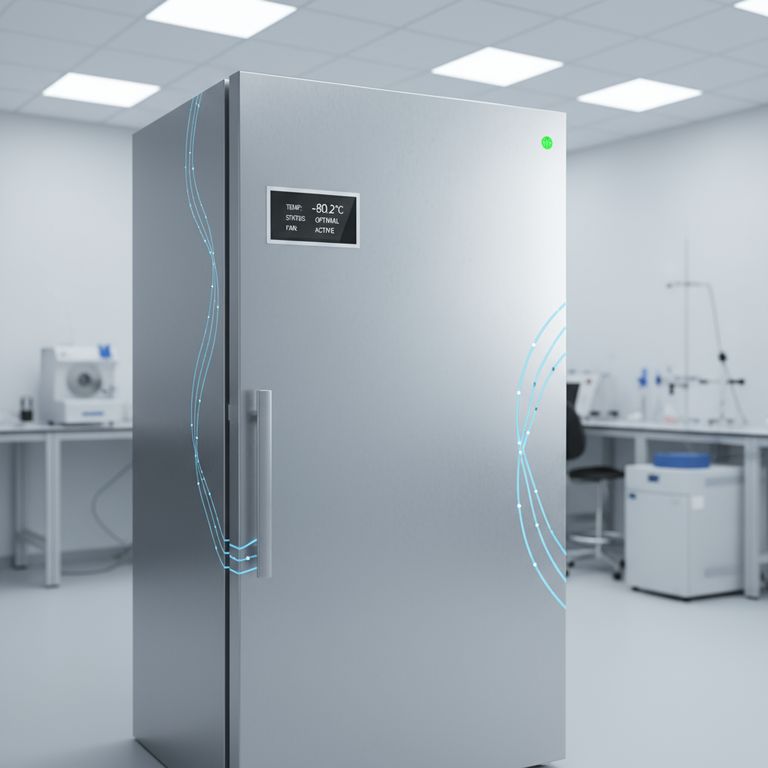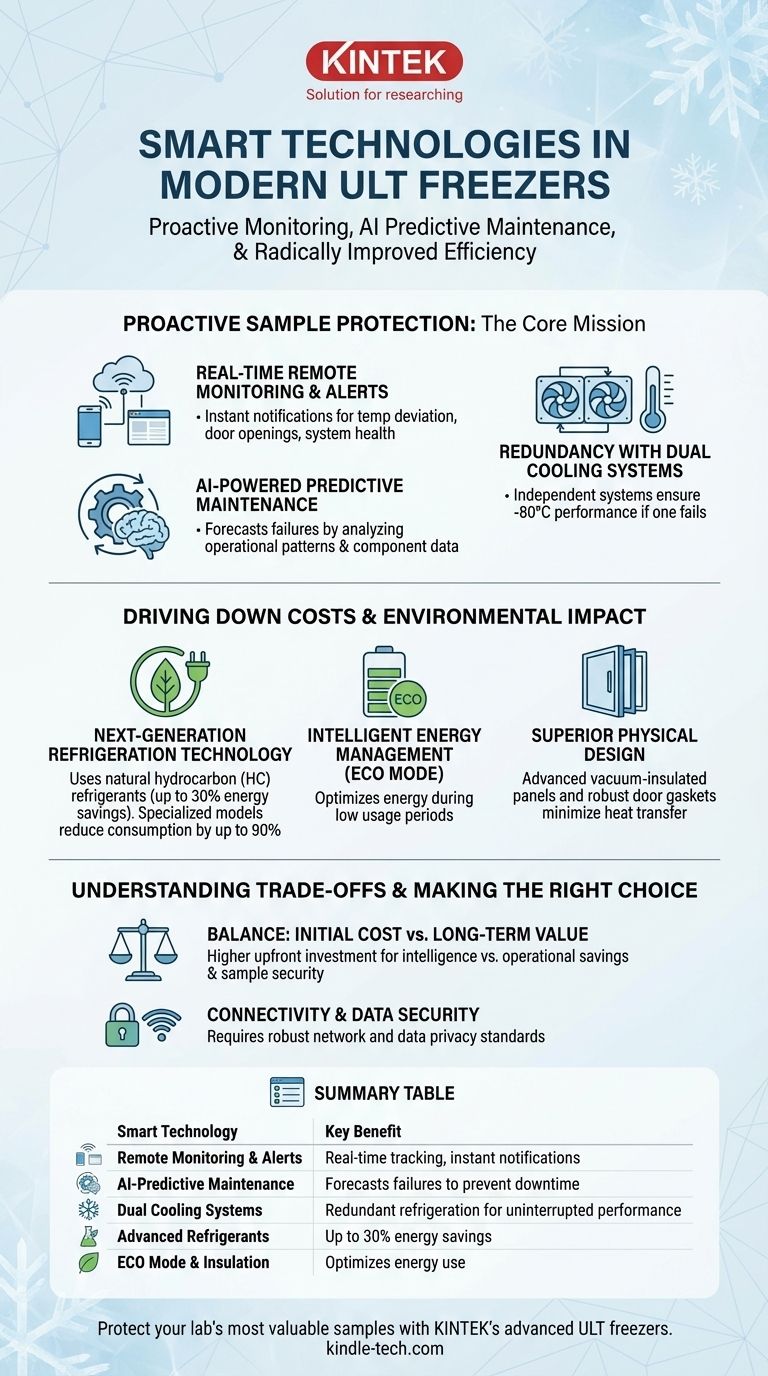At their core, modern Ultra-Low Temperature (ULT) freezers are incorporating smart technologies focused on three key areas: proactive remote monitoring, AI-driven predictive maintenance, and radically improved energy efficiency. These systems allow lab managers to track performance in real-time via alerts, use artificial intelligence to forecast failures before they happen, and leverage advanced refrigeration to slash operational costs.
The evolution of the ULT freezer is not just about adding digital features. It's a fundamental shift from a passive cold box to an intelligent, active system designed to proactively protect valuable samples, minimize energy consumption, and prevent catastrophic failures.

The Core Mission: Proactive Sample Protection
The highest priority for any lab is the security of its biological samples, which are often irreplaceable. Modern smart features are built around preventing loss through foresight and redundancy.
Real-Time Remote Monitoring and Alerts
These systems are the new standard for sample security. They connect the freezer to the cloud, allowing authorized personnel to monitor internal temperatures, door openings, and system health from any web browser or mobile device.
If temperature deviates from the setpoint, the system instantly sends an alert via text, email, or app notification. This allows for immediate intervention long before samples are compromised.
AI-Powered Predictive Maintenance
This is a significant leap beyond simple alarms. AI algorithms continuously analyze operational data, such as compressor run times, temperature recovery rates, and ambient conditions.
By recognizing subtle patterns that precede a component failure, the system can predict a potential breakdown. This enables labs to schedule maintenance proactively, avoiding unexpected downtime and the frantic rush to save samples from a failing unit.
Redundancy with Dual Cooling Systems
While not a digital technology, this is a critical "smart design" feature for reliability. These freezers contain two independent refrigeration systems.
If one system fails, the other is capable of maintaining the temperature at -80°C on its own. This built-in backup provides a crucial safety net, giving lab staff ample time to arrange for service without risk to the freezer's contents.
Driving Down Costs and Environmental Impact
ULT freezers are notoriously energy-intensive, with a single unit often consuming as much electricity as an entire household. Smart innovations are directly tackling this challenge.
Next-Generation Refrigeration Technology
The biggest gains in efficiency come from a complete overhaul of the cooling mechanics. Manufacturers are moving away from older, less efficient hydrofluorocarbon (HFC) refrigerants.
Modern units now use natural hydrocarbon (HC) refrigerants, like propane and ethane, which can improve energy efficiency by up to 30%. Some specialized models even use liquid nitrogen or Stirling cycle coolers, which can reduce energy consumption by as much as 90% compared to traditional compressor-based systems.
Intelligent Energy Management (ECO Mode)
Many smart freezers feature an "ECO mode" that optimizes energy use without compromising sample integrity. This mode allows the system to operate within a slightly wider temperature band, minimizing compressor cycles during periods of low usage, such as overnight or on weekends.
Superior Physical Design
Smart efficiency is also about fundamental physics. Modern ULT freezers use advanced vacuum-insulated panels and robust door gaskets to minimize heat transfer from the outside.
Better insulation means the cooling system works less hard to maintain its target temperature, directly translating to lower, more consistent energy consumption.
Understanding the Trade-offs
While smart technologies offer clear advantages, they introduce new considerations that must be weighed.
The Cost of Intelligence
Freezers equipped with AI, dual cooling systems, and advanced refrigerants carry a higher initial purchase price. The decision hinges on balancing this upfront capital investment against long-term operational savings and the immense financial and scientific value of the samples being protected.
Complexity and Connectivity
A smart freezer is a networked device. This means its monitoring and alert capabilities are dependent on the reliability of your lab's Wi-Fi or ethernet network. A network outage could temporarily disable remote functions, highlighting the need for a robust IT infrastructure.
Data Security Concerns
As with any IoT device, remote monitoring systems transmit operational data over a network. Labs must ensure that the freezer's platform meets their internal data security and privacy standards to prevent unauthorized access or tampering.
Making the Right Choice for Your Goal
The ideal ULT freezer depends entirely on your lab's primary objective.
- If your primary focus is sample irreplaceability: Prioritize models with both a dual cooling system for redundancy and AI-powered predictive maintenance to prevent failures entirely.
- If your primary focus is reducing operational costs: Scrutinize the refrigeration technology; units with hydrocarbon (HC) refrigerants or Stirling cycle engines offer the most significant long-term energy savings.
- If your primary focus is simplified lab management: Select a freezer with an intuitive and highly customizable remote monitoring platform that provides clear, actionable alerts.
Ultimately, today's ULT freezer is evolving into an active and intelligent partner in your research.
Summary Table:
| Smart Technology | Key Benefit |
|---|---|
| Remote Monitoring & Alerts | Real-time temperature tracking and instant notifications via app/email |
| AI-Predictive Maintenance | Forecasts component failures to prevent downtime and sample loss |
| Dual Cooling Systems | Redundant refrigeration for uninterrupted -80°C performance |
| Advanced Refrigerants (e.g., HC) | Up to 30% energy savings vs. traditional systems |
| ECO Mode & Superior Insulation | Optimizes energy use during low-activity periods |
Protect your lab’s most valuable samples and reduce operational costs with KINTEK’s advanced ULT freezers. Our smart freezers integrate AI-driven predictive maintenance, real-time remote monitoring, and energy-efficient hydrocarbon refrigerants to ensure sample integrity while slashing energy usage. Whether you prioritize irreplaceable sample security or long-term savings, KINTEK provides reliable lab equipment tailored to your needs. Contact us today to find the ideal ULT freezer for your laboratory!
Visual Guide

Related Products
- 508L Advanced Vertical Ultra Low Temperature Freezer for Critical Laboratory Storage
- 408L Advanced Vertical Laboratory Ultra Low Temperature Freezer for Critical Research Material Preservation
- 58L Precision Laboratory Ultra Low Temperature Upright Freezer for Critical Sample Storage
- 158L Precision Vertical Ultra Low Freezer for Laboratory Applications
- 808L Precision Laboratory Vertical Ultra Low Temperature Freezer
People Also Ask
- What advantages do ultra-low temperature freezers offer? Ensure Long-Term Sample Integrity and Reliability
- What makes Ultra-Low Temperature freezers energy efficient? Key Design & Operational Strategies
- What is the price range for ultra low temperature freezers? Protect Your Samples with the Right Investment
- What are ultra low temperature freezers used for? Preserving Critical Biological Samples for Decades
- Where are ultra low temperature freezers commonly used? Essential for Labs, Hospitals, and Biotech



















